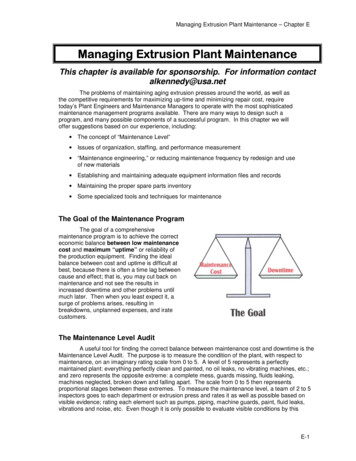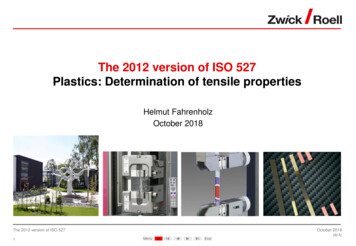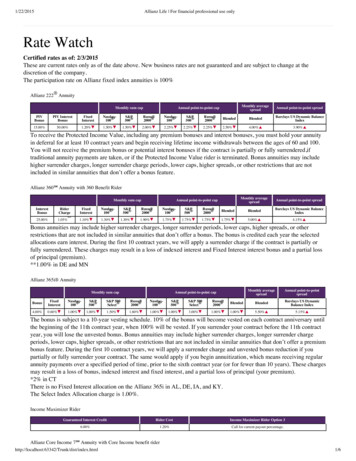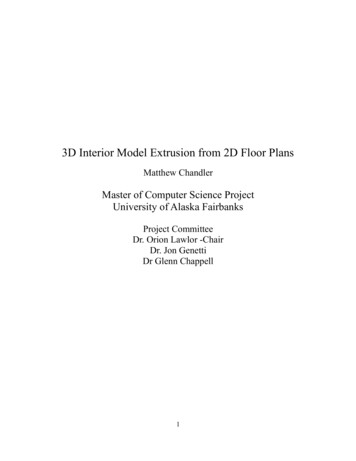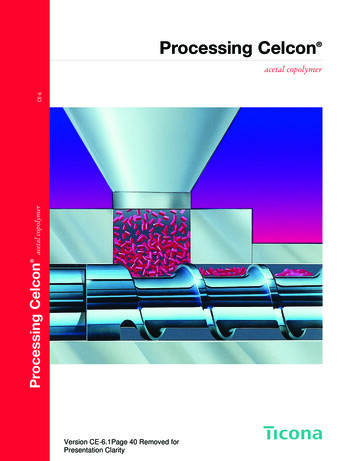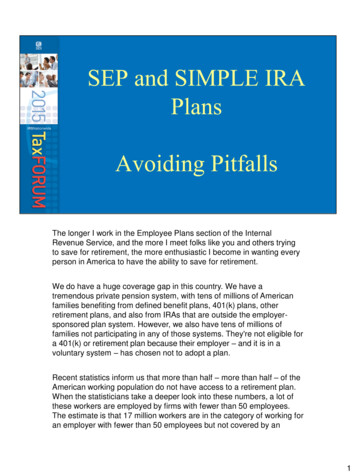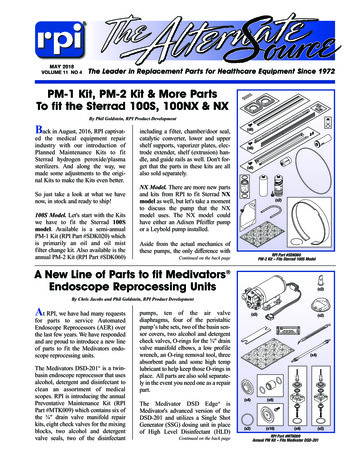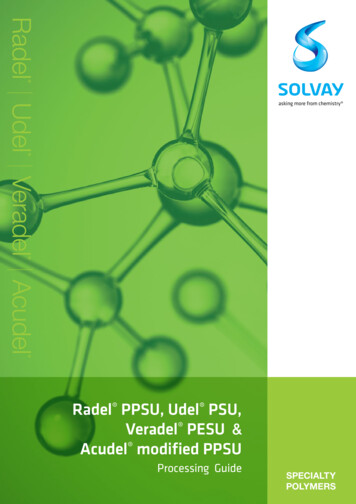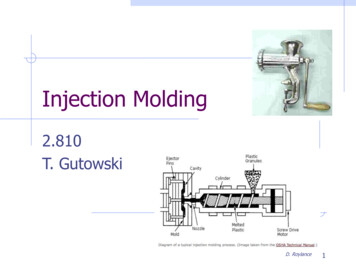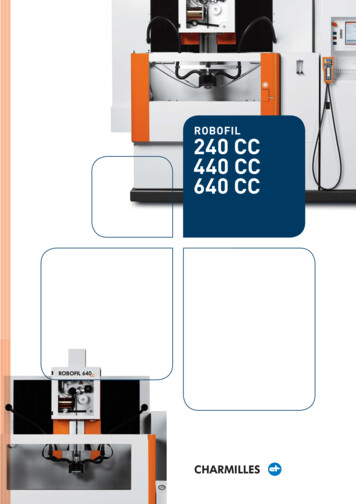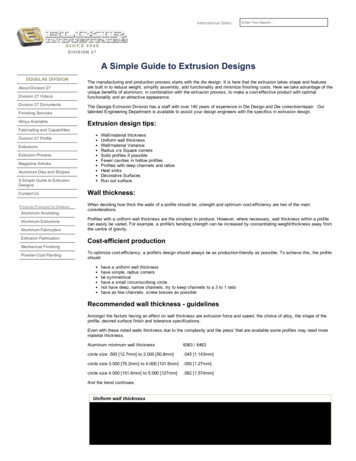
Transcription
International SalesEnter Your Search.D IV IS ION 2 7A Simple Guide to Extrusion DesignsDOUGLAS DIVISIONAbout Division 27Division 27 VideosDivision 27 DocumentsFinishing ServicesAlloys AvailableThe manufacturing and production process starts with the die design. It is here that the extrusion takes shape and featuresare built in to reduce weight, simplify assembly, add functionality and minimize finishing costs. Here we take advantage of theunique benefits of aluminum, in combination with the extrusion process, to make a cost effective product with optimalfunctionality and an attractive appearance.The Georgia Extrusion Division has a staff with over 140 years of experience in Die Design and Die correction/repair. Ourtalented Engineering Department is available to assist your design engineers with the specifics in extrusion design.Extrusion design tips:Fabricating and CapabilitiesDivision 27 ProfileExtrusionsExtrusion ProcessMagazine ArticlesAluminum Dies and ShapesA Simple Guide to ExtrusionDesignsWall/material thicknessUniform wall thicknessWall/material VarianceRadius v/s Square cornersSolid profiles if possibleFewer cavities in hollow profilesProfiles with deep channels and ratiosHeat sinksDecorative SurfacesRun out surfaceContact UsWall thickness:Products Produced by DivisionsWhen deciding how thick the walls of a profile should be, strength and optimum cost efficiency are two of the mainconsiderations.Aluminum AnodizingAluminum ExtrusionsAluminum FabricationExtrusion FabricationProfiles with a uniform wall thickness are the simplest to produce. However, where necessary, wall thickness within a profilecan easily be varied. For example, a profile's bending strength can be increased by concentrating weight/thickness away fromthe centre of gravity.Cost efficient productionMechanical FinishingPowder Coat PaintingTo optimize cost efficiency, a profile's design should always be as production friendly as possible. To achieve this, the profileshould:have a uniform wall thicknesshave simple, radius cornersbe symmetricalhave a small circumscribing circlenot have deep, narrow channels, try to keep channels to a 3 to 1 ratiohave as few channels, screw bosses as possibleRecommended wall thickness guidelinesAmongst the factors having an effect on wall thickness are extrusion force and speed, the choice of alloy, the shape of theprofile, desired surface finish and tolerance specifications.Even with these noted walls thickness due to the complexity and the press' that are available some profiles may need morematerial thickness.Aluminum minimum wall thickness6063 / 6463circle size .500 [12.7mm] to 2.000 [50.8mm].045 [1.143mm]circle size 3.000 [76.2mm] to 4.000 [101.6mm].050 [1.27mm]circle size 4.000 [101.6mm] to 5.000 [127mm].062 [1.574mm]And the trend continues.Uniform wall thicknessIt is often acceptable to have a large range of wall thicknesses within a single profile. However, a profile withuniform wall thickness is easier to extrude (below right).
In the drawing below you can see in the left hand profile that the internal and external walls have a differentthickness. It is an advantage if the internal and external walls are of the same thickness (below right). Thisdecreases die stress and improves productivity.Print this pageWall/material VarianceIt is of course perfectly acceptable for a profile to have walls of different thicknesses. For example, for strengthreasons, it may be best to concentrate weight/thickness away from the centre of gravity.Radius cornersThe extrusion process cannot achieve razor sharp corners without additional fabrication. Corners should berounded. A radius of .020r .040r [0.5 1mm] is often sufficient.A design may demand sharp internal angles, a profile that may enclose a box shape. This is easily solved byincorporating a recessed corner.
As far as possible sharp tips should be avoided. The tip can easily become wavy and uneven or possible havinga tearing result when extruded. Tips should therefore also be rounded.And for accurate measurements dimensioned to a tangent instead of an intersection.This extrusion on the left showing the square corners, with large variations in wall thickness cools unevenly. Thiscauses visible structural unevenness that is particularly noticed after anodizing. Always use radii to blendcorners.Solid profiles if possibleThe part on the left is a double void hollow if you can eliminate the voids it will be best. Solid profilesreduce die costs and are often easier to produce.
Fewer cavities in hollow profilesThis hollow profile is extremely complex to produce.Notice it has (9) hollow voids.By replacing the hollow profile above with these two telescoping profiles, the product is considerably easier toproduce. And you will also need to consider extrusion tolerances when designing mating parts.It's best to have as few of voids as possible, reducing the number of cavities in a hollow profile makes it easier toextrude. This also increase dies stability. While reducing the number of cavities also consider keeping the internalwalls as short as possible.Deep channels and ratiosFor profiles with channels (tongues), there is a basic rule that the height to width ratio should be approximately 3to 1. This is best for an extrusion die and ensures that the strength of the die is not jeopardized. (example height.300 [7.62]x width .100 [2.54])By using large radii at the opening of the channel, and a full radius at the bottom, the ratio can be increased to 4to 1 but again the ratio is higher so expect more breakage.
Where channel width is under .079 [2 mm], or where a profile's design is complex, permissible channel depthmust be determined on a case by case basis.It may be possible to increase radii and opening dimensions without compromising functionality. Here, a holderhas to enclose a slide. After redesigning the holder on the (left) gives a more extrusion friendly profile andimproved functionality.A profile can be extruded "open" and then rolled into shape. This also reduces the tongue ratio and it will take asecond process to close the shape up which usually calls for a brake press.The solution below shows a narrow, deep channel and an extrusion friendly profile. The designer will need to thinkabout tongue depth and ratios.Reduced channel depth using a step. Adding a wall in this case makes the gap opening easier to control.
Heat sinksThe use of cooling fins on profiles greatly increases the heat dissipating area. This can be further increased bygiving the fins a wavy surface. Where there is forced air cooling longitudinally along the profile, it is better toleave the fins smooth. An undulating surface increases the heat dissipation area of fins, as shown in the close upimage below.The profile below exemplifies technical development. Large profiles with deep channels yet tight tolerances arerespected and there is a high quality surface finish. It's best to keep this type of design as symmetrical aspossible. This type die is more acceptable for die breakage and tongue shift and very hard to produce in somecases due to the variance in wall thickness and high tongue ratios.Decorative SurfacesDecorations have several advantages:DesignMasking of imperfectionsProtection against damage during handling and machining
A decorative pattern can make a plain aluminum surface more attractive.The consistent use of a pattern on all a product's component profiles can help make it uniquely identifiable. Thereare endless possibilities for creating unique designs.For mating parts a joint can be hidden by making it part of a fluted design.Masking of imperfectionsWhere a profile has, for example, arms and screw ports, there may be process induced shadowing (heat zones)opposite such features. Using decoration the heat zones can be completely masked.Protection against damageWell designed decoration can also protect profiles from handling and machining damage.Run out surface:All extrusions have a run out surface.What is a run out surface? Run out surface is the part of the extrusion that will be on the extrusion press table.This area of the shape will have some marks scratched, carbon, and possible dents.To explain why: The aluminum profile is at roughly 1000 degrees when it comes out of the press which thematerial is very soft.
Elixir SnapshotElixir DetailsElixir Industries is a leader in AluminumExtrusions, Aluminum Fabrication and CustomMetal Fabrication Products. Elixir Industries hasbeen a leading manufacturer of manufacturedhousing doors since its humble beginnings in1948. Elixir Industries has grown into amanufacturing giant that today includes twomillion square feet of production space and 12divisions nationwide.Privacy PolicyMetal manufacturing services: CNCManufacturing, Laser Cutting, Water Jet Cutting,CNC Breaking, CNC Punching, AluminumExtrusion, Extrusion FabricationA glimpse of a few of our products: EntranceDoors, Steel & Aluminum Window Guards, DoorHardware, Putty Tapes, Sealants, Cargo TrailerDoors, Aluminum Siding, Roll Roofing, SteelFraming, Sports EquipmentSome of the industries we serve are:Recreational Vehicles, Factory Built Homes,Cargo Trailers, Lighting, Academic andCommunity Athletic Programs.Site MapCopyright 2015 Elixir Industries
A Simple Guide to Extrusion Designs Contact Us Products Produced by Divisions Aluminum Anodizing Aluminum Extrusions Aluminum Fabrication Extrusion Fabrication Mechanical Finishing Powder Coat Painting Aluminum minimum wall thickness circle size .500 [12.7mm] to 2.0
